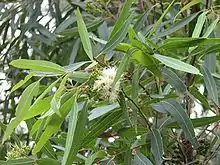Eucalyptus curtisii
Eucalyptus curtisii, commonly known as Plunkett mallee,[2] is a species of mallee or small tree that is endemic to south-east Queensland in Australia. It has smooth grey to silvery bark, lance-shaped, narrow elliptic or curved adult leaves, flower buds in groups of seven, white flowers and wrinkled, cup-shaped fruit.
| Plunkett mallee | |
|---|---|
 | |
| Eucalyptus curtisii in Maranoa Gardens | |
| Scientific classification | |
| Kingdom: | Plantae |
| Clade: | Tracheophytes |
| Clade: | Angiosperms |
| Clade: | Eudicots |
| Clade: | Rosids |
| Order: | Myrtales |
| Family: | Myrtaceae |
| Genus: | Eucalyptus |
| Species: | E. curtisii |
| Binomial name | |
| Eucalyptus curtisii | |
Description
Eucalyptus curtisii is a slender mallee or small tree that typically grows to a height of 7–12 m (23–39 ft) and forms a lignotuber. It has smooth grey to silvery bark that is shed in short curly flakes. Young plants and coppice regrowth have linear to narrow lance-shaped leaves that are 30–62 mm (1.2–2.4 in) long and 3–6 mm (0.12–0.24 in) wide and a slightly darker shade of green on the upper surface. Adult leaves are lance-shaped, elliptic or curved, glossy green but much paler on the lower surface. They are 60–140 mm (2.4–5.5 in) long and 10–30 mm (0.39–1.18 in) wide on a petiole 7–18 mm (0.28–0.71 in) long. The flower buds are arranged in groups of seven on a branching inflorescence near the ends of the stems, each branch with groups of seven buds. The groups are on a peduncle 7–17 mm (0.28–0.67 in) long, the individual buds on a pedicel 2–5 mm (0.079–0.197 in) long. Mature buds are oval to pear-shaped, 5–8 mm (0.20–0.31 in) long and 4–7 mm (0.16–0.28 in) wide with a rounded operculum. Flowering occurs from September to December and the flowers are white to creamy white. The fruit is a woody cup-shaped, wrinkled capsule 5–11 mm (0.20–0.43 in) long and 6–11 mm (0.24–0.43 in) wide.[2][3][4][5]
Taxonomy and naming
Eucalyptus curtisii was first formally described in 1931 by William Blakely and Cyril White from a specimen collected on sandstone hills "near Plunkett, [now Plunkett Conservation Park], about 33 mi (53 km) south-west of Brisbane". The description was publish in Proceedings of the Royal Society of Queensland.[6][7] The specific epithet (curtisii) honours Densil Curtis, a farmer and naturalist, who collected the type specimens in 1923 and 1929.[3][7]
Distribution and habitat
Plunkett mallee grows in shrubland and open forest in poorly drained sites between Beenleigh, Inglewood, Dalby, and Theodore in south-east Queensland .[2][3]
Cultural references
Eucalyptus curtisii was adopted by Ipswich City Council as its floral emblem in 1996.[8]
See also
References
- "Eucalyptus curtisii". Australian Plant Census. Retrieved 19 May 2019.
- Chippendale, George M. "Eucalyptus curtisii". Australian Biological Resources Study, Department of the Environment and Energy, Canberra. Retrieved 19 May 2019.
- "Eucalyptus curtisii". Euclid: Centre for Australian National Biodiversity Research. Retrieved 4 June 2020.
- "Plunkett mallee – Eucalyptus curtisii". Queensland Government Department of Environment and Science. Retrieved 19 May 2019.
- "Eucalyptus curtisii". Australian National Botanic Gardens. Retrieved 19 May 2019.
- "Eucalyptus curtisii". APNI. Retrieved 19 May 2019.
- Blakely, William F. (1931). "Two Interesting Queensland Eucalypts". Proceedings of the Royal Society of Queensland. 42 (9): 82–84. Retrieved 19 May 2019.
- "Floral Emblem". Ipswich City Council. Archived from the original on 8 December 2006. Retrieved 18 March 2012.